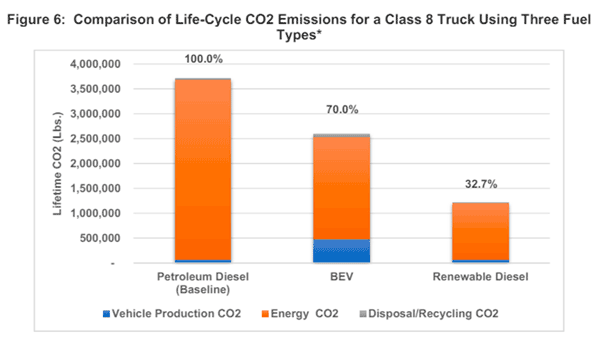A new study from the American Transportation Research Institute (ATRI) says so-called Renewable Diesel fuel is an attractive alternative to reduce CO2 emissions in the trucking sector.
What is Renewable Diesel (RD)?
Supply Chain Digest Says...
|
 |
| |
“While a regulation requiring RD trucks to convert to BEV may be well intentioned, in reality it more than doubles the CO2 emissions output of a sample fleet when using RD,” ATRI says. |
What do you say? |
| Click here to send us your comments |
 |
| |
|
It is a fuel that is produced to be chemically identical to petroleum (oil-based) diesel, meaning RD can be mixed with petroleum diesel in any amount or used as a standalone, drop-in fuel in a traditional diesel truck without any issues..
There are several methods for producing RD, with the most common being “hydrotreating.”
ATRI says that in the hydrotreating process, lipids from feedstocks of vegetable or animal products, or waste, are reacted with hydrogen under high temperature and pressure to remove water and oxygen. Other steps are then used to separate out the final RD product.
The transportation sector is the end-user for nearly all petroleum diesel consumed in the US. Across the sector, which includes trucks, buses, rail and maritime, more than 46.4 billion gallons were consumed in 2023 (including biodiesel and renewable diesel blended into petroleum diesel).
Perhaps surprising to some, in 2023 RD consumption levels reached 2.868 billion gallons annually in the US. This represents a 66.9% increase from consumption in 2022, which was 1.718 billion gallons.This growth in RD is being driven primarily by regulatory requirements in California, where nearly three-quarters of Rd was consumed last year.
The report says there are various levels of RD feedstocks, such as food products like soy bean oil (level 1), waste materials (level 2), algae (level 3), and use of genetic engineering to improve organic feedstocks.
Levels 3 and 4 are in the research and development phase at present.
At the beginning of 2023 the US had 17 RD plants in 11 states with a production capacity of 3 billion gallons per year, ATRI says. US production capacity of RD increased nearly 280 percent in the two years from January 2021 – when there were only six plants in the US – to January 2023.
Additionally, the US Energy Information Administration (EIA) forecasts that domestic capacity will again more than double between the end of 2022 and the end of 2025, from 2.6 billion gallons per year to 5.9 billion gallons per year.
Environmental Benefits of RD Usage
Past ATRI research that switching from an truck that uses petroleum diesel to a battery-electric (BEV) truck would decrease CO2 emissions by 30%. That same research found that using RD in an existing truck could decrease the trucking industry’s carbon footprint even more effectively than BEV trucks. The per-truck life-cycle CO2 reduction using RD compared to petroleum diesel is 67.3%. (See graphic below – please note BEV CO2 includes grid electricity generation and emissions from vehicle/battery production, the same with RD truck production.)

Source: ATRI
(See More Below)
“While a regulation requiring RD trucks to convert to BEV may be well intentioned, in reality it more than doubles the CO2 emissions output of a sample fleet when using RD,” ATRI says.
As always with ATRI, there is much more data analysis, specifically looking at cost and operational performance, with most looking favorable for RD trucks, though there are many variables (such as the unpredictable cost of feedstocks).
The report concludes by stating that “This report demonstrates that ICE RD is a far more effective tool to decarbonize long-haul trucking than BEV.”
It bases that opinion by noting the following advantages for RD:
• Environmentally: There is simply more CO2 produced by a BEV than an ICE RD truck across the full trucj life-cycle.
• Operationally: BEV trucks cannot do the same job as an ICE RD – in terms of uninterrupted mileage, revenue weight and even the ability to refuel when needed. All of these factors limit the potential emission reductions of BEV trucks.
• Financially: BEV vehicle and infrastructure costs are far more expensive than ICE RDcosts.
The full ATRI report is available with registration here: Renewable Diesel – A Catalyst for Decarbonization
Any thoughts on renewable diesel? Let us know your thoughts at the Feedback section below.
|